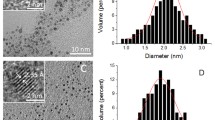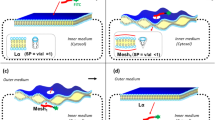Abstract
Purpose. The objective of this work is to evaluate the ability of peptides derived from the bulge (HAV-peptides) and groove (ADT-peptides) regions of E-cadherin EC1-domain to increase the paracellular porosity of the intercellular junctions of Madin-Darby canine kidney (MDCK) cell monolayers.
Methods. Peptides were synthesized using a solid-phase method and were purified using semi-preparative HPLC. MDCK monolayers were used to evaluate the ability of cadherin peptides to modulate cadherin-cadherin interactions in the intercellular junctions. The increase in intercellular junction porosity was determined by the change in transepithelial electrical resistance (TEER) values and the paracellular transport of 14C-mannitol.
Results. HAV- and ADT-peptides can lower the TEER value of MDCK cell monolayers and enhance the paracellular permeation of 14C-mannitol. HAV- and ADT-decapeptides can modulate the intercellular junctions when they are added from the basolateral side but not from the apical side; on the other hand, HAV- and ADT-hexapeptides increase the paracellular porosity of the monolayers when added from either side. Conjugation of HAV- and ADT-peptides using ω-aminocaproic acid can only work to modulate the paracellular porosity when ADT-peptide is at the N-terminus and HAV-peptide is at the C-terminus; because of its size, the conjugate can only modulate the intercellular junction when added from the basolateral side.
Conclusions. Peptides from the bulge and groove regions of the EC1 domain of E-cadherin can inhibit cadherin-cadherin interactions, resulting in the opening of the paracellular junctions. These peptides may be used to improve paracellular permeation of peptides and proteins. Furthermore, this work suggests that both groove and bulge regions of EC-domain are important for cadherin-cadherin interactions.
Similar content being viewed by others
REFERENCES
K. L. Lutz and T. J. Siahaan. Molecular structure of the apical junction complex and its contribution to the paracellular barrier. J. Pharm. Sci. 86:977–984 (1997).
K. L. Lutz, S. Bogdanowich-Knipp, D. Pal, and T. J. Siahaan. Structure, function and modulation of E-cadherins as mediators of cell-cell adhesion. Curr. Top. in Pept. Prot. Res. 2:69–82 (1997).
J. L. Madara. Tight junction dynamics: Is paracellular transport regulated? Cell 53:497–498 (1988).
J. M. Anderson and C. M. Van Itallie. Tight junctions and the molecular basis for regulation of paracellular permeability. Am. J. Physiol. 269:G467–G475 (1995).
A. Adson, T. J. Raub, P. S. Burton, C. L. Barsuhn, A. R. Hilgers, K. L. Audus, and N. F. H. Ho. Quantitative approaches to delineate paracellular diffusion in cultured epithelial cell monolayers. J. Pharm. Sci. 83:1529–1536 (1994).
K. L. Lutz and T. J. Siahaan. Modulation of the cellular junction protein E-cadherin in bovine brain microvessel endothelial cells by cadherin peptides. Drug Delivery 4:187–193 (1997).
D. Pal, K. L. Audus, and T. J. Siahaan. Modulation of cellular adhesion in bovine microvessel endothelial cells by a decapeptide. Brain Res. 747:103–113 (1997).
I. T. Makagiansar, M. Avery, Y. Hu, K. L. Audus, and T. J. Siahaan. Improving selectivity of HAV-peptides in modulating E-cadherin-E-cadherin interactions in the intercellular junctions of MDCK cell monolayers. Pharm. Res. 18:446–453 (2001).
B. Gumbiner. Structure, biochemistry, and assembly of epithelial tight junctions. Am. J. Physiol. 253:749–758 (1987).
B. Gumbiner. The role of the cell adhesion molecule uvomorulin in the formation and maintenance of the epithelial junctional complex. Cell. Biol. 107:1575–1587 (1988).
A. W. Koch, D. Bozic, O. Pertz, and J. Engel. Homophilic adhesions by cadherins. Curr. Opin. Struc. Biol. 9:275–281 (1999).
M. Takeichi. Cadherin cell adhesion receptors as a morphogenetic regulator. Science 251:1451–1455 (1991).
M. Takeichi. The cadherins: Cell-cell adhesion molecules controlling animal mophogenesis. Development 102:639–655 (1988).
M. Takeichi. Cadherins: A molecular family important in selective cell-cell adhesion. Annu. Rev. Biochem. 59:237–252 (1990).
I. Makagiansar, E. Sinaga, A. Calcagno, R. Xu, and T. J. Siahaan. Roles of E-cadherin and β-catenin in cell adhesion and signaling and possible therapeutic application. Curr. Top. Biochem. Res. 2:51–61 (2000).
M. Overduin, T. Harvey, S. Bagby, K. Tong, P. Yau, M. Takeichi, and M. Ikura. Solution structure of the epithelial cadherin domain responsible for selective cell-adhesion. Science 267:386–389 (1995).
B. Nagar, M. Overduin, M. Ikura, and J. M. Rini. Structural basis of calcium-induced E-cadherin rigidification and dimerization. Nature 380:360–364 (1996).
L. Shapiro, A. M. Fannon, P. D. Kwong, A. Thompson, M. S. Lehmann, G. Grubel, J. F. Legrand, J. Als-Nielsen, D. R. Colman, and W. A. Hendrickson. Structural basis of cell-cell adhesion by cadherins. Nature 374:327–337 (1995).
J. Alattia, H. Kurokawa, and M. Ikura. Structural view of cadherin-mediated cell-cell adhesion. Cell. Mol. Life Sci. 55:359–367 (1999).
C. L. Adams and W. J. Nelson. Cytomechanics of cadherinmediated cell-cell adhesion. Curr. Opin. Cell Biol. 10:572–577 (1998).
I. T. Makagiansar, P. D. Nguyen, A. Ikesue, K. Kuczera, W. Dentler, J. L. Urbauer, N. Galeva, M. Alterman, and T. J. Siahaan. Disulfide bond formation promotes the cis-and transdimerization of the E-cadherin derived first repeat (E-CAD1). J. Biol. Chem. 277:6002–10010 (2002).
S. Chappuis-Flament, E. Wong, L. D. Hicks, C. M. Kay, and B. M. Gumbiner. Multiple cadherin extracellular repeats mediate homophilic binding and adhesion. J. Cell Biol. 154:231–243 (2001).
A. Nose, K. Tsuji, and M. Takeichi. Localization of specificity determining sites in cadherin cell adhesion molecules. Cell 61:147–155 (1990).
K. L. Lutz, L. A. Szabo, D. L. Thompsons, and T. J. Siahaan. Antibody recognition of peptide sequences from the cell-cell adhesion proteins: N-and E-cadherins. Pept. Res. 9:233–239 (1996).
K. L. Lutz and T. J. Siahaan. E-cadherin peptide sequence recognition by an anti-E-cadherin antibody. Biochem. Biophys. Res. Commun. 211:21–27 (1995).
M. Takeichi. Morphogenetic roles of classic cadherins. Curr. Opin. Cell. Biol. 7:619–627 (1995).
K. Boller, D. Vestweber, and R. Kemler. Cell-adhesion molecule uvomorulin is localized in the intermediate junctions of adult intestinal epithelial cells. J. Cell Biol. 100:327–332 (1985).
G. Christofori and H. Semb. The role of the cell-adhesion molecule E-cadherin as a tumour suppressor gene. Trends. Biochem. Sci. 24:73–76 (1999).
M. Katayama, S. Hirai, K. Kamihagi, K. Nakagawa, M. Yasumoto, and I. Kato. Soluble E-cadherin fragments increased in circulation of cancer patients. Br. J. Cancer 69:580–585 (1994).
J. Behrens, W. Birchmeier, S. L. Goodman, and B. A. Imhof. Dissociation of MDCK cells by the monoclonal antibody anti-arc-1: Mechanistic aspects and identification of the antigen as a component related to uvomorulin. J. Cell Biol. 101:1307–1315 (1985).
L. Gonzalez-Mariscal, B. Chavez de Ramirez, and M. Cereijido. Tight junction formation in cultured epithelial cells (MDCK). J. Membr. Biol. 86:113–125 (1985).
O. Pertz, D. Bozic, A. W. Koch, C. Fauser, A. Brancaccio, and J. Engel. A new crystal structure, Ca2+ dependence and mutational analysis reveal molecular details of E-cadherin homoassociation. Embo J. 18:1738–1747 (1999).
K. L. Lutz, D. Pal, K. L. Audus, and T. J. Siahaan. Inhibition of E-cadherin-mediated cell-cell adhesion by cadherin peptides. In J. P. Tam and P. T. P. Kaumaya. (eds.), Peptides: Frontiers of Science, Kluwer Academic Press, Boston, 1999 pp. 753–754.
J. M. Berman, M. Goodman, T. M. Nguyen, and P. W. Schiller. Cyclic and acyclic partial retro-inverso enkephalinamides: Mu receptor selective enzyme resistant analogs. Biochem. Biophys. Res. Commun. 115:864–870 (1983).
N. Chaturvedi, M. Goodman, and C. Bowers. Topochemically related hormone structures. Synthesis of partial retro-inverso analogs of LH-RH. Int. J. Pept. Protein Res. 17:72–88 (1981).
Rights and permissions
About this article
Cite this article
Sinaga, E., Jois, S.D.S., Avery, M. et al. Increasing Paracellular Porosity by E-Cadherin Peptides: Discovery of Bulge and Groove Regions in the EC1-Domain of E-Cadherin. Pharm Res 19, 1170–1179 (2002). https://doi.org/10.1023/A:1019850226631
Issue Date:
DOI: https://doi.org/10.1023/A:1019850226631




